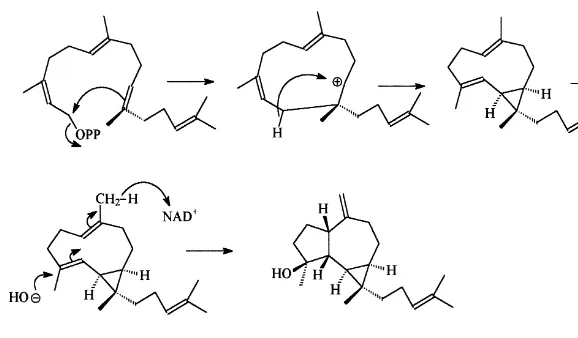*Corresponding author. Tel.:#27-31-260-3090; fax:#27-31-260-3091.
E-mail address:[email protected] (D.A. Mulholland)
Biochemical Systematics and Ecology 28 (2000) 713}716
Isolation of Cneorubin X, an unusual diterpenoid
from
Ptaeroxylon obliquum (Ptaeroxylaceae)
Dulcie A. Mulholland
*
, Hamdani A. Mahomed
Natural Products Research Group, Department of Chemistry, University of Natal, Durban, 4041, South Africa
Received 12 May 1999; accepted 14 June 1999
Keywords: Ptaeroxylon obliquum; Cedrelopsis grevei; Ptaeroxylaceae; Diterpenoid; Cneorubin X; Cneoraceae;Neochamaelea pulverulenta(synCneorum pulverulentum);Cneorum tricoccon;Cneorum trimerum
1. Subject and source
Bark of Ptaeroxylon obliquum (Ptaeroxylaceae) was collected and identi"ed by N. Crouch in December, 1998 from Silverglen Nature Reserve in Durban and a voucher specimen retained (Crouch 772, NH).
2. Previous work
The generaPtaeroxylonandCedrelopsishave been grouped together by Styles and Pennington into the Ptaeroxylaceae family due to similarity in their morphology and structure of the secondary xylem. The monospeci"c genusPtaeroxylonhad previously been placed in the Sapindaceae, the Rutaceae, and most popularly, in the Meliaceae families. The pollen ofCedrelopsisandPtaeroxylonare very similar, unlike that of any Meliaceae pollen grain but similar to that of some Rutaceae (Styles and Pennington, 1975). The grouping together ofCedrelopsisandPtaeroxylonis supported by chemical evidence: the wood of both was found to contain a variety of chromones and coumarins but no limonoids (Dean and Taylor, 1966; Dean et al., 1967a}c; McCabe et al., 1967; Eshiett and Taylor, 1968; Dean and Robinson, 1971). We have recently
isolated two limonoid derivatives, cedmiline and cedmilinol, from the bark of Ced-relopsis greveifrom Madagascar (Mulholland et al., 1999).These limonoid derivatives are unusual in that the C-9, C-10 bond has been cleaved, C-30 has been inserted between C-7 and C-8, ring A has undergone modi"cation and carbon atoms have been lost from ring D. A literature search revealed that these limonoid derivatives most closely resembled those from the Cneoraceae family (Mondon and Epe, 1983), for example, cneorin Kfrom Neochamaelea pulverulenta(Mondon et al., 1978). This prompted the present investigation of the bark of the South African species
Ptaeroxylon obliquum.
3. Present work
Milled and dried bark (319.5 g) was extracted successively in a Soxhlet apparatus with hexane, methylene chloride, and methanol. NMR experiments on the crude extracts indicated no limonoids, coumarins or chromones. The hexane extract (6.24 g) yielded, after column chromatography over silica gel (Merck 9385), the diterpenoid cneorubin X (348 mg) which was isolated only twice previously,"rstly fromCneorum tricoccon (Cneoraceae) (Trautmann et al., 1980) and secondly from the soft coral,
Sinularia spp.(Anjaneyulu et al., 1997). The structure was determined from IR and NMR (1H,13C, COSY, HETCOR) experiments and con"rmed by comparison of data against literature values. A proposed biosythesis of this three ring compound from geranyl geranyldiphosphate is given in Fig. 1. The co-occurrence of cneorubin Y with cneorubin X inCneorum tricoccon (Trautmann et al., 1980) indicates that the cyclo-propyl ring is formed"rst.
4. Chemotaxonomic signi5cance
Fig. 1. Proposed biosynthesis of Cneorubin X.
common in the Cneoraceae. The coumarin cedrelopsin has been isolated from Ced-relopsis grevei(Eshiett and Taylor, 1968) andNeochamaelea pulverulenta(Dictionary of Natural Product, 1994). The chromone ptaeroglycol has been isolated from
Ptaeroxylon obliquum(Dean et al., 1967c), Cedrelopsis grevei (Dean and Robinson, 1971) andNeochamaelea pulverulenta(Mondon and Callsen, 1975), another chromo-ne, ptaerochromenol, has been isolated fromPtaeroxylon obliquum(Dean et al., 1967a) and its methyl ether has been obtained fromCneorum tricoccon(Gonzales et al., 1974).
Acknowledgements
This research was funded by the University of Natal Research Fund and the Foundation for Research Development. We thank Dr. Neil Crouch of the National Botanical Institute for the provision of plant material.
References
Anjaneyulu, A.S.R., Krishnamurthy, M.V.R., Rao, G.V., 1997. Tetrahedron 53, 9301.
Dean, F.M., Parton, B., Price, A.W., Somvichien, N., Taylor, D.A.H., 1967a. Tetrahedron Lett. 29, 2737. Dean, F.M., Parton, B., Somvichien, N., Taylor, D.A.H., 1967b. Tetrahedron Lett. 23, 2147.
Dean, F.M., Parton, B., Somvichien, N., Taylor, D.A.H., 1967c. Tetrahedron Lett. 36, 3459. Dean, F.M., Robinson, M.L., 1971. Phytochemistry 10, 3221.
Dean, F. M., Taylor, D. A. H., 1966. J. Chem. Soc. C 114.
Dictionary of Natural Products, Vol. 1, 1994. Chapman & Hall, New York, p. 905. Eshiett, I. T., Taylor, D. A. H., 1968. J. Chem. Soc. C 481.
Gonzalez, A.G., Fraga, B.M., Pino, O., 1974. Phytochemistry 13, 2305. McCabe, P. H., McCrindle, R., Murray, R. D. H., 1967. J. Chem. Soc. C 145.
Mondon, A., Callsen, H., 1975. Chem. Ber. 108, 2005. Mondon, A., Epi, B., 1983. Prog. Chem. Org. Prod. 44, 101.
Mondon, A., Epe, B., Trautmann, D., 1978. Tetrahedron Lett. 49, 4881.
Mulholland, D. A., Mahomed, H., Kotsos, M., Randrianarivelojosis, M., Lavaud, C., Massiot, G., Nuzillard J. M., 1999. Tetrahedron 55, 11547.
Styles, B.T., Pennington, T.D., 1975. Blumea 22, 476.
Trautmann, D., Epe, B., Oelbermann, U., Mondon, A., 1980. Chem. Ber. 113, 3848.
